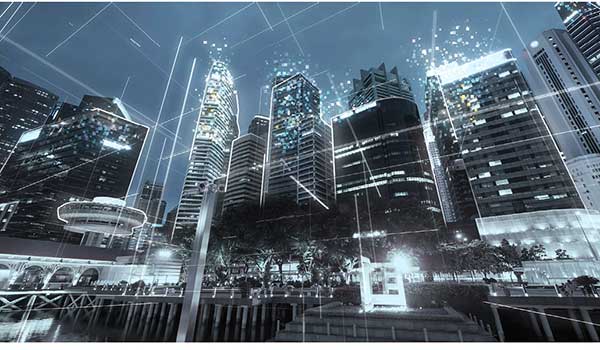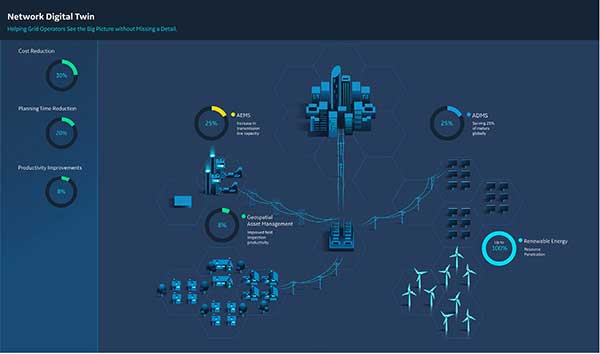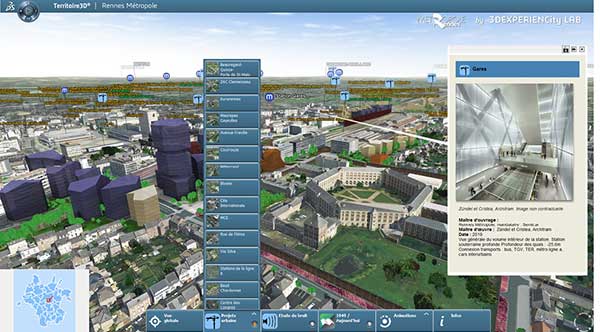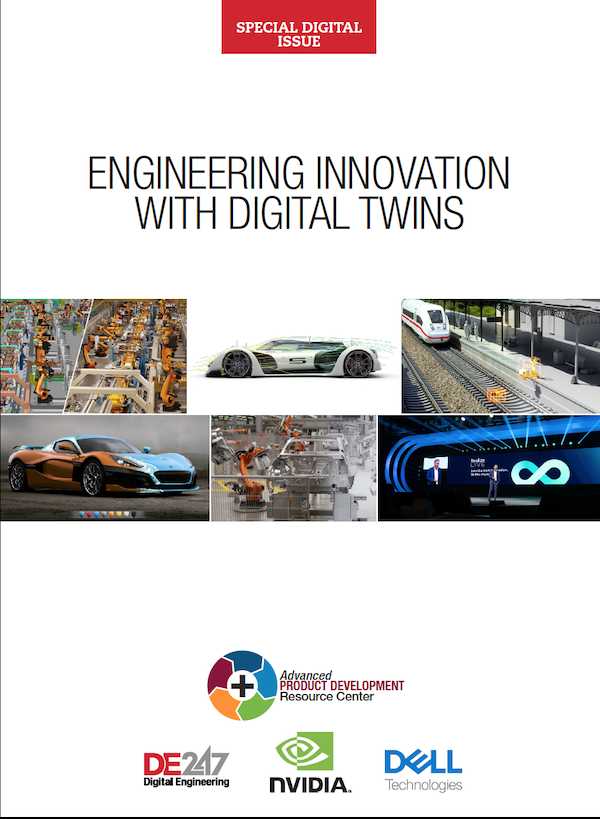Digital Twins Form Building Blocks for Smart Cities
The combination of 3D models, simulations and real-time IoT data means smart city digital twins are being tapped to optimize everything from traffic patterns to energy efficiency.

Cityzenith’s SmartWorldPro digital twin technology aggregates, integrates, analyzes and visualizes smart city project data on a single 3D platform. Image courtesy of Cityzenith.
Latest News
January 4, 2021
Digital twins, a concept rapidly gaining traction as a way to improve product design, create proactive maintenance services and optimize performance of industrial assets, are starting to take shape on an entirely different scale as they become the building blocks for futuristic smart cities.
In a smart city design context, digital twins function as a virtual replica of a city’s assets; think buildings, roads, traffic patterns, lighting systems, mobility solutions, energy and grid capabilities. But it’s not enough to create a 3D representation of these resources.
Just like a product digital twin, a digital twin of a smart city pairs 3D information, spatial modeling of a built environment, simulations and mathematical models of electric and mechanical systems with real-time data feeds from Internet of Things (IoT) platforms such as sensor-integrated buildings and equipment. Smart city digital twins also incorporate other private and public data sources to deliver a living, breathing representation of an urban space.
With a smart city digital twin in hand, utility companies can optimize and create self-sustaining and renewable energy grids, first responders could run what-if scenarios to prepare for emergency scenarios such as fires or floods, and city planners could map out and manage traffic patterns to circumvent congestion and counter the effects of urban sprawl with well-placed vegetation and parks.
Melding the physical and virtual worlds together in a digital twin can help city planners and administrators make better decisions, keep citizens informed and engaged, and be a mechanism for addressing major public health, safety and environmental issues.
For engineers designing components for municipalities of the future—autonomous vehicles, public transit fleets, smart lighting systems or buildings—the smart city digital twin becomes a key part of the development cycle, to inform design requirements and for feedback on how that asset operates under real-world conditions. As smart city architects delve deeper into design and planning, digital twins of core assets will become a requisite as they aim to create a holistic picture.
“[Urban planning clients] are increasingly demanding a digital twin at the design stage that can be connected to the information sources to be used downstream,” explains Michael Jansen, chairman and CEO of Cityzenith, maker of the SmartWorldPro digital twin platform.
“They want a digital twin because they want to explore their energy costs over 10 years—it’s not enough to say we’re going to deliver a good product. They want answers and to be able to run scenarios,” Jansen says. “There’s an ability for the design community to provide evidence-based results using a digital twin and it will be a game changer for the ones that do it better.”
Twinning on the Rise
Whether playing a role in the design of smart cities or smart products, use of digital twin technologies is expanding. The digital twin market is projected to surge from its current market value of approximately $4 billon to over $35 billion by 2026, according to a recent study by market research firm Global Market Insights. Gartner Research estimates that three-quarters of organizations implementing IoT projects already use or plan to use digital twins within a year.
As the concept evolves, Gartner expects organizations to integrate multiple digital twins. For example, as in a power plant where digital twins of each piece of equipment are synced for a composite picture used to analyze overall operations. Similarly, myriad design twins could be connected to create a composite of smart city infrastructure.
Gartner says 61% of companies implementing digital twins have already integrated at least one pair of individual digital twins, and 74% plan to execute on that approach over the next five years.

“The biggest thing we’re looking for with smart cities is how to get systems to interconnect and convert the city into a system of systems,” explains Sean Moser, senior vice president for digital product management for GE Digital’s Grid Software team. Unlike a typical product digital twin, which is focused on mimicking the physics of materials or product behavior, a digital twin in the context of a smart city is about simulating a dynamic system.
“Think of a digital twin simulating the physics of a part or a component, and then a digital representation of a full machine,” Moser says. “The aggregation of these things continues to catenate and becomes encapsulated into a digital twin of a smart city.”
Dassault Systèmes has been actively immersed in a number of pioneering smart city projects. Its 3DEXPERIENCity platform is being used to create Virtual Singapore, a $73 million project to design a 3D city model and collaborative data platform for building a more resilient and sustainable city.

Using tools such as CATIA and SIMULIA, Singapore planners are creating a unified 3D data model that all public agencies, businesses and researchers can leverage for various use cases, from determining the best place to install solar panels, to analyzing pedestrian patterns, to planning buildings with an eye toward minimizing wind tunnels, according to Simon Huffeteau, Dassault’s vice president of Construction, Cities and Territories.
The Dassault tools suite is also helping build the 3DEXPERIENCity Virtual Rennes project, including one use case involving a large-scale visualization aimed at helping planners in the French city optimize green spaces. By capturing detail such as the quantity, type, age and location of trees, the city is creating a virtual twin of the urban canopy.
“A digital twin of a city is not a pure physical digital mockup,” Huffeteau says. “A virtual twin allows you to simulate and represent the complexities of the real world the way it operates on a daily basis.”
Twinning Smart Cities
As interest in digital twins—and digital twins for smart city design, in particular—grows, various vendors are stepping up, in addition to Dassault Systèmes.
Bentley Systems and Microsoft recently announced an expanded alliance to combine Microsoft’s Azure IoT Digital Twins and Azure Maps with Bentley Systems’ iTwins platform, enabling engineers, architects and city planners to work within a city-scale digital twin.
As part of their collaboration, the companies are offering ProjectWise 365, an Azure cloud-based solution for increasing the speed and quality of infrastructure design collaboration. They are also working on integrations that ensure the Bentley iTwins platform can leverage Azure Digital Twins, Azure IoT Hub and Azure Time Series Insights for storing and processing operational data.
Other use cases and smart city digital twin tool sets include:
Climate change and resiliency. Cityzenith is one of the leaders in this space with its SmartWorldPro Version 2 digital twin technology, which aggregates, integrates, analyzes and visualizes smart city project data on a single 3D platform. The platform, currently underpinning more than two dozen building and smart city initiatives around the world, is primarily being adopted to help cities and urban planners deal with the effects of climate change, Jansen says.
“The ability to aggregate data at scale helps them develop climate-resilient strategies at scale,” he says.
For example, as part of New Mexico’s new “smart infrastructure” and its carbon-neutral energy initiative, SmartWorldPro will model the replacement smart energy infrastructure. The country’s fifth largest fossil fuel power is driving a multi-billion-dollar project that includes solar and wind arrays to power the state while generating surplus for trading on energy markets.
Cityzenith’s SmartWorldPro platform is also the information model foundation for Amaravati, a new $6.5 billion smart city capital being developed for the Indian state of Andhra Pradesh. The digital twin platform will accelerate the development of advanced mobility and traffic monitoring solutions and advanced microclimate and climate change monitoring systems. Multi-nodal IoT sensors, in conjunction with Smart World Pro, provide real-time construction monitoring and environmental and wellness monitoring.
Autonomous vehicles and mobility solutions. Traffic patterns and mobility solutions are big issues in smart city design, and simulations and digital twins can play a significant role. Whether mapping out where smart traffic lights should be installed or creating the safest intersections, digital twins get city planners and mobility solutions designers closer to how things actually look as new technologies and infrastructure come on board, according to Karen Giese, Smart Cities program management for Siemens Mobility and Intelligent Traffic Systems.
Unlike traditional simulation models, which assume perfection in vehicle design and behavior, a digital twin is dynamic, taking in real-time information from sensors, LiDAR and cameras to capture a vehicle’s perspective and providing a level of granularity that hasn’t been seen before.
“The more you can create a digital twin of the environment in which a vehicle ultimately is going to operate, the better you know you’re designing that vehicle to be successful,” Giese says. “You need a digital twin from the chips in the controller to the mechanical and electrical systems to the digital twin of traffic and the city.”
One effort that provides a glimpse of where Siemens is going is its partnership with the Fédération Internationale de l’Automobile (FIA) and Bentley Systems to improve the safety of spectators and drivers at Rally events. Connected vehicle technology, 3D models and simulations created in Simcenter Amesim, artificial intelligence (AI) image classification and sensor networks from Siemens Intelligent Traffic Systems and Siemens PLM Software groups will create a digital twin of select Rally stages and to help detect dangerous locations for spectators. The concepts and lessons learned will eventually be evolved for the next phase: to help improve pedestrian safety in cities, officials say.
Smart utilities and the grid. Another big digital twin application for smart cities involves energy efficiency and optimizing management of the electricity grid. This is an area GE Digital has staked out with a variety of its products and services; as of 2018, the company had 1.2 million digital twins for 300,000 assets ranging from individual pieces of equipment to entire power plants.
In one specific example, GE just released an AI-driven Visual Intelligence platform for utilities that ingests all forms of visual inspection data and executes automated analysis to contextualize data into a digital twin of a utility network. That twin then helps facilitate asset inspection and vegetation management, and allows utility companies to do predictive maintenance to trees and other vegetation that could cause power failures during high winds and storms.
Though much about the smart city digital twins impact urban planners, construction companies and architects, participation from design engineers will eventually become an imperative.
“When you’re an engineer working in a given framework and set of requirements for your product, you are not isolated—there is always a multi-scale element to it,” says Dassault’s Huffeteau. “Being able to connect these elements is clearly part of the vision and future of all virtual twins.”
More Dassault Systemes Coverage

More GE Digital Coverage
Subscribe to our FREE magazine, FREE email newsletters or both!
Latest News
About the Author
Beth Stackpole is a contributing editor to Digital Engineering. Send e-mail about this article to [email protected].
Follow DE






